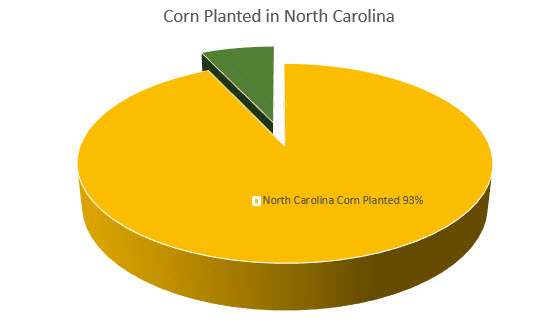North Carolina leads the country in corn planting
By Diego Flammini
Assistant Editor, North American Content
Farms.com
Almost three quarters of the total U.S. corn crop has been planted, according to the USDA’s Weekly Weather and Crop Bulletin for the week of May 7 to 14.
The number is up slightly from the 70 percent five-year average.
On a state level, producers in North Carolina lead the country with 93 percent of their corn in the ground, which is on par with the five-year average.

Farmers in Tennessee, Missouri, Iowa and Minnesota all have more than 80 percent of their corn planted, and each state is above their recorded five-year averages.
31 percent of the corn crop has emerged, according to the USDA’s latest figures. This figure is down from a five-year average of 36 percent.
North Carolina has the highest recorded corn emergence at 86 percent, up 5 percent from its five-year average.
Tennessee has 74 percent and Texas has 72 of its corn emerged.
Soybeans
32 percent of the American soybean crop has been planted, according to the report.
Louisiana leads all states with 86 percent of its soybeans planted, up from a five-year average of 70 percent.
Mississippi producers reported 81 percent of their soybean crop planted, and Arizona reported 62 percent of its soybean crop has been planed. Both states are up from their respective five-year averages.
Only 8 percent of the total soybean crop has emerged, says the USDA.
Louisiana reported 76 percent of its crop emerged, Mississippi with 72 percent and Arizona with 49 percent.

Winter Wheat
Nationwide, 63 percent of the winter wheat crop has headed, up from the five-year average of 57 percent.
Arizona leads all states with 100 percent of its winter wheat headed, which is a 5 percent increase from the average over five years.
California, Missouri, North Carolina, Oklahoma and Texas all reported more than 90 percent of their winter wheat crop headed.
Oregon leads all states when it comes to the crop’s condition, with 28 percent reported as ‘excellent.’
California reported 80 percent of its crop as ‘good.’
Spring Wheat
78 percent of the spring wheat crop has been planted nationally as of May 14.
South Dakota leads all stats with 99 percent of its crop planted, up from the five-year average of 90 percent.
Minnesota reported 93 percent of its spring wheat crop planted, up from a five-year average of 68 percent.
Fieldwork Days
The top states, in terms of weekly days suitable for field work as of May 14 were:
1) Arizona - 7
2) Utah – 6.8
3) California, New Mexico and Florida – 6.6
4) North Dakota and Montana – 6.4
The states with the fewest number of suitable workdays were:
1) New York - 2.5
2) Maine – 2.1
3) Illinois – 1.9
4) Indiana – 1.8
5) Ohio – 1.7
Weekly Precipitation Levels as of May 14
State | Precipitation (in inches) | Weather Station |
Illinois | 1.55 | Rockford |
Indiana | 1.58 | South Bend |
Iowa | 1.33 | Burlington |
Kentucky | 1.57 | Lexington |
Michigan | 0.15 | Lansing |
Missouri | 1.16 | Springfield |
New York | 1.02 | Albany |
Ohio | 1.15 | Cincinnati |
Pennsylvania | 1.82 | Philadelphia |
Tennessee | 2.08 | Britsol |
The next Weekly Weather and Crop Bulletin is scheduled for release on Tuesday, May 23.